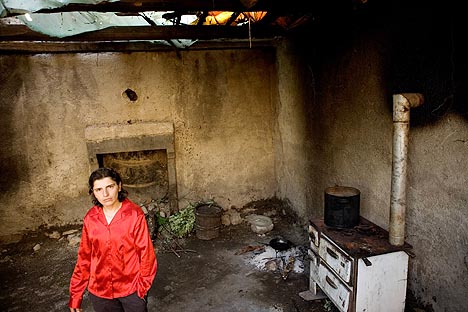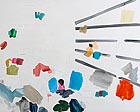
translated and summarized by: Liz Wollner-Grandville,
English summary June 15 -21
Kunsthaus Nexus: Erwin Wurm – Rudolf Budja Collection
The antiquated smirk of sculptures
Soothing and reassuring, not only at first inspection, and almost stimulating: an exhibition, which doesn’t force the visitor to play along or laugh: an exception – considering that Erwin Wurm is the puppet master. The compact sceneries of his mini-retrospective, currently shown at the Kunsthaus Nexus in Saalfelden, in Rudolf Budja’s (“the other” Salzburg Festival gallery owner) collection, lets Wurm perceive himself as having being raised to the indisputable status of a classical sculptor. And this is something that Wurm had always wanted to be perceived as.
The exhibition deliberately omitted his concept-bearing works, whose sketched instructions demonstrate the theme “sculpture as a form of action” far too didactically (Peter Weibel). And, which would - at the most - animate the smirking mob of artsy party people to denude themselves, or possibly even to make a fool of themselves for a split second with their backs to, or through, the wall. Where the charming smirk of the objects can easily turn into one-handed knee-slapping. It’s humour - even if one doesn’t laugh (even if it is amusing).
By Stephan Maier
Kunsthaus Nexus
5760 Saalfelden, Am Postplatz 1, until 11.07.09
www.kunsthausnexus.com
Kunsthalle Mannheim, Wilhelm-Hack-Museum: Anton Henning – Antonym
There has never been so much Henning!
Two museums are currently devoting a joint one-man-show to the Berlin-born artist Anton Henning (born 1964) with more than 140 paintings, drawings, sculptures and video works. This is the largest solo exhibit ever accorded to the artist. And there is another sensation: the cities Mannheim and Ludwigshafen have not cooperated for more than 10 years - although they are only separated by the Rhine River. The “Antonym” exhibition is currently presented both at the Wilhelm-Hack-Museum Ludwigshafen and at the Kunsthalle Mannheim - until August 16, 2009.
While the museum in Ludwigshafen takes a retrospective look at Henning’s oeuvre dating from 1990 to today, the Mannheim show concentrates on his sculptures, lighted paintings with heavy massive wooden frames and the new Quadrinomes. Those are large four-sided wooden creations in a case, with four paintings on each side and the entire case set on one leg. Along the top ledge there is fluorescent lamp, which lights the respective painting. Hulky and ever-present they stand-alone and faintly remind of advertising columns or billboard cases in public space. Henning successfully created a unique and convincing nexus between painting and sculpture. For the presentation of his works in the Kunsthalle the exhibition space was painted in dark gray and only minimally lit, thereby allowing the paintings to unfold their own light and to mediate a pleasant and warm atmosphere.
Henning is a wayfarer between the worlds - or rather between art historical styles and eras – without loss of his own style. Without effort he cites Velasquez, Picasso or Gerhard Richter, cheerfully and buoyantly transforms works by Mondrian, Arp or the abstract Matisse in his series “Jazz” and with his style of lightness bestows them with a colourful and fresh currentness. Without the slightest effort he portrays cows or Bauhaus chairs, such as the cantilever chair, over which he casually hangs a noose and, clamps a cigarette and a brush between its loops – a hidden self-portrait? In any case, there is an abundance of self-portraits at this exhibit. Repeatedly, Henning presents himself: e.g. as a nude at the beach with large clouds in the background – to be seen at the Ludwigshafen exhibition. It seems as if he wants to make sure that he exists as a painter and wants to set a sign of life – for good. His international success proves his presence to himself, and so do his multifaceted and cheerful accomplishments under the sun.
By Ulrike Lehmann
Kunsthalle Mannheim
68165 Mannheim, Friedrichsplatz 4, until 16.08.09
www.kunsthalle-mannheim.de
Wilhelm-Hack-Museum
67059 Ludwigshafen, Berliner Strasse 23, until 16.08.09
www.wilhelmhack.museum
Startgalerie im Museum auf Abruf: Anjeza Cikopano – Bread, Salt, and Heart
Life on the brink of history
Archaic as old sagas and oppressively realistic depictions of poverty, – these photos spontaneously throw one far back in time. Again and again one is reminded of Louis Bunuel’s “Land without Bread”, depicting “medieval” life in a Spanish mountain village in the 1930s.
The artist, born in Albania in 1979, shows well composed and touching, yes - even shocking motives. The central theme of these photos is the fate of women, who live in a region in Northern Albania where the ancient customary law, the Kanun, is still in force. Although these women have practically no rights, the photos are not perceived as accusations, on the contrary – the women are presented with respect for their life situation and in their different contexts. The dignity radiated by these photos is effected through the cautiously designed image compositions, reminding of middle-class Western-European traditions. Alone through the display detail and the colouring scheme, the old woman sitting on the shabby sofa next to the simple brick-built fireplace reminds of representative depictions of wealthy middle class citizens of the 19th century.
The only photo showing someone laughing emanates the emotion of touching beauty. The young woman’s face contrasts the drawn and dreary semblance of the other women. Not knowing anything – no names, no life stories - about her or any of the others, increases the effect of the pictures.
But these impressive photos makes one wish for more information on this world at the brink of today and its inhabitants.
By Wolfgang Pichler
Startgalerie im Museum auf Abruf
1010 Vienna, Felderstr. 6-8, next to the city hall, until 09.08.09
www.musa.at/startgalerie
layr:wuestenhagen contemporary: In Memory of Painting 2 /Rita Vitorelli
In memory of painting
Following Franz Amann’s creations shown in the series “in Memory of Painting” are now Rita Vitorelli’s paintings. The exhibition series, in whose conceptualisation Vitorelli was involved, is accompanied by lectures and discussions.
But does she still want to paint? The seemingly empty, large formatted pictures with their white or gray backgrounds show pale pencil drawings of hinted at objects, all of which are only fragmentarily painted-in with strong aquarelle-like colours. “O.T.” (2009) is the depiction of a chaotic and abandoned youth’s room, and two paintings from the series “Goutte d’Or” (2006), show the same scattered chaos with implied flowers in hinted at outer rooms.
“Discarded objects are thrown down, often carelessly painted,” is Vitorelli’s formal counterpart for trash, perceived as a motif for a meaning- and careless party throwaway-society’s still life. Often, the objects are no longer clearly identifiable. The colour flecks only fill in the outlines of something, except for cans and bottles, which remain recognizable as such. Vitorelli does not even depict the objects with reduced lines; she abstracts them to such an extent that they lose their actual character. Only the way in which the amorphous items are arranged offers a hint regarding their meaning.
Rita Vitorelli’s paintings are meta-cartographies of surroundings in highest entropy. She utilizes the style of the indeterminate inchoate to represent the dissolved reality in the midst of a large emptiness – nevertheless, the painting is complete, because – and that is the actual ingenuity of Rita Vitorelli’s works: they are full-fledged images of a setting as it is perceived, but not apprehended.
By Renate Quehenberger
layr:wuestenhagen contemporary
1010 Vienna, An der Hülben 2, until 25.07.09
www.layrwuestenhagen.com
Mehr Texte von translated and summarized by: Liz Wollner-Grandville


 Teilen
Teilen



